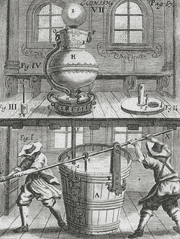|

Experiment on the force of the vacuum.
Gaspar Schott, Technica curiosa, sive, Mirabilia artis, Würzburg
1664
|
Despite the fact that it seems untouchable,
the air around us can hold up cargo-planes and blow down buildings.
What gives it this substance, out of reach of our senses? Air contains
an incredible number of molecules: around 25 billion billion per cm³
. In the space equivalent to a pin-head, there are millions of times
as many molecules as there are people living on our planet.
Air molecules (which are 99% nitrogen and
oxygen) move tirelessly at the speed of 450 metres/second (faster than
the speed of sound) and each molecule hits other ones 5 billion times
a second. The pressure of a gas comes from these collisions. This is
why the billions of molecules which push, for example, inside a tube
of a tyre, give a shove powerful enough to hold up a lorry. The movement
of these molecules, and therefore also their pressure, goes up noticeably
when the temperature goes up. And that's one of the basic principles
of thermodynamics.
|

